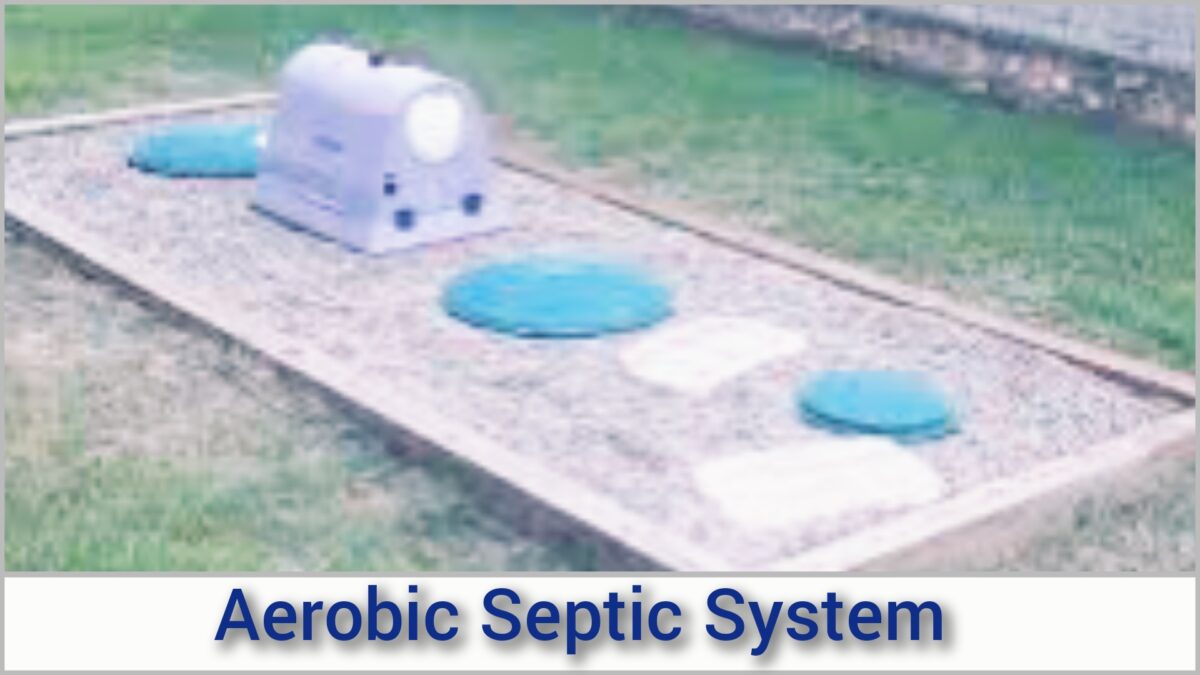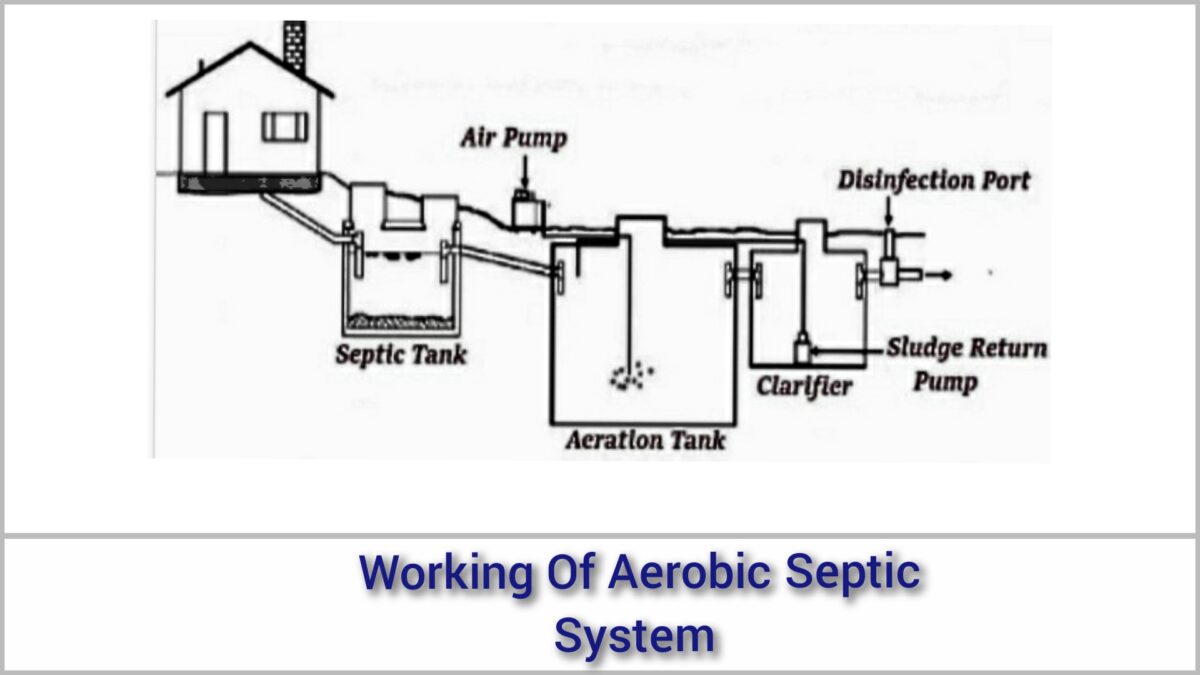This article explains aerobic septic system, how aerobic system work, conventional septic tank system, components of an aerobic treatment system, cost of aerobic septic system, maintenance, advantages, disadvantages and other related terms.

Table of Contents
Aerobic Septic System – Explanation
An aerobic septic system, also referred to as an aerobic treatment system (ATS), employs an aerobic process to digest sewage and is a small-scale wastewater treatment method.
The aerobic septic system operates in a similar way to a septic tank system, but it utilizes an aerobic process instead of an anaerobic process.
These systems are typically utilized in areas where public sewage systems are not available, such as for a single-family home or a small group of houses.
Aerobic treatment systems produce high-quality secondary sewage that can be further purified and used for surface irrigation, unlike traditional septic tank systems. This allows for greater flexibility in the placement of the leach field and reduces the necessary size of the leach field.
The aerobic septic system injects oxygen (O2) into the processing tank, which increases the natural bacterial activity in the system, helping to further break down nutrients in the sewage. Some aerobic systems also contain a pre-treatment tank and a final treatment tank that includes disinfection to further reduce pathogen levels.
This system is advantageous for houses with poor soil conditions or narrow lots, as well as for areas with a high water table or houses near surface water that are susceptible to contamination from nutrients present in sewage. It should be noted that regular maintenance of the aerobic treatment unit (ATU) is necessary for the life of the system.
Aerobic Septic System Cost
The cost of various aerobic septic systems are given in the following table:
| Type of Aerobic Septic System | Cost Range |
|---|---|
| Conventional/Gravity Septic Tank with Uniform Distribution | $20,000 – $30,000 |
| Aeration Treatment System (Type 2) | $25,000 – $35,000 |
| ATU with Underground Drip Irrigation Line | $25,000 – $36,000 |
| ATU with Evo-transpiration Bed | $25,000 – $41,000 |
Working Concept
An aerobic treatment system is a type of sewage treatment system that utilizes mechanical components to treat sewage and discharge the treated wastewater into an absorption area. The system utilizes aerobic bacteria that require oxygen to survive.

These aerobic bacteria use oxygen to process organic matter that flows through the septic system. They cannot function without both organic matter and oxygen. In contrast, the anaerobic bacteria found in conventional septic tank systems require an oxygen-deprived environment.
In an aerobic septic system, the bacteria reside in puddles or mud. The surface or diffusion aerator simultaneously supplies additional oxygen and organic waste into the system. The bacteria consume the sewage products, breathe the air, and release CO2 as waste products.
The aerobic treatment system is comprised of several processes that work together to deliver high-quality wastewater.
The first process is pre-treatment, which involves placing a septic tank in front of the Aerobic Treatment Unit (ATU) or using a septic or trash tank as part of the system’s equipment. This pre-treatment step separates solids from the wastewater.
The second process is the aeration chamber. In this step, a blower or air compressor forces air to mix with the wastewater. This step promotes the growth of aerobic bacteria, which helps to digest solids in the effluent.
The third process is disinfection, which involves an additional treatment step for the wastewater leaving the ATU or ATI-J. This step can use UV light or chlorine to treat the wastewater before it enters the pump tank.
The final process is the disposal of the treated wastewater into the drainage area. This area can be an evapotranspiration bed, an absorption area, or a sand filter.
Conventional Septic Tank System
A conventional septic tank system is a straightforward device used for treating domestic wastewater. Typically, this system comprises a septic tank and drainage ditches or an underground sewage infiltration system, commonly known as a drain field. It is a popular choice for single-family homes and small businesses.
The design of the stone/gravel drain field has been in use for a long time and is named after its structure. The conventional septic tank system functions as follows:
The sewage from the septic tank is directed into underground trenches consisting of flat gravel or stone.
A geo-fabric material is then placed on top of the trench to prevent dust, sand, or other debris from entering the clean stone.
The wastewater passes through the stone and is then treated by microorganisms when it reaches the soil beneath the stone or gravel trench.
The stone or gravel system’s total area is relatively large and may not be suitable for all areas and living conditions.
Parts Of Aerobic Treatment System

An aerobic treatment system typically comprises several components, including a trash tank, an aerobic treatment unit (ATU), a disinfection chamber, a pump tank, and an absorption field. Here is a detailed breakdown of each component:
- Trash Tank: Similar to a conventional septic tank, the trash tank collects sewage and separates it into three layers: a scum layer on top, a central liquid sewage layer, and a lower mud layer. The wastewater then flows through a T-shaped baffle and enters the aerobic treatment unit.
- Aerobic Treatment Unit (ATU): The ATU uses aerobic bacteria to treat wastewater. By supplying air, the system creates an oxygen-rich environment in which aerobic bacteria can break down harmful pathogens in the wastewater. The ATU requires mechanical parts and electricity to function.
- Disinfection Chamber: After leaving the ATU, the wastewater enters the disinfection chamber. Here, various processes such as UV light, chlorine, bleach, or other disinfection methods further treat the wastewater before it is discharged into the pump tank.
- Pump Tank: The pump tank contains sensors that monitor the wastewater level and notify you when it requires pumping. A pipe or nozzle connects the tank to the absorption field, where the wastewater is distributed for final treatment.
Requirement Of Aerobic Septic System
Aerobic septic systems offer several benefits, making them an excellent choice for homeowners or property owners. One of the most significant advantages of an aerobic septic system is that it requires a small installation area, which is beneficial for properties with limited space. The size of the septic tank typically depends on the number of people living in a house or building, and many conventional septic tanks require a lot of space for installation.
Another advantage of an aerobic septic system is that it provides higher levels of treatment for wastewater, resulting in cleaner water and reduced risk of groundwater pollution. This is particularly important for homes located in areas with a high-water table, where water contamination is a concern.
Aerobic septic systems are also environmentally friendly since they allow for the easy recycling and reuse of wastewater for watering lawns and gardens. The wastewater flows through the system, is treated, and then reprocessed, making it an excellent option for those who want to reduce their environmental impact.
Compared to conventional septic systems, aerobic systems can break down solid waste more efficiently, reducing the need for frequent pumping and maintenance. Additionally, aerobic septic systems are suitable for all types of land, making them a versatile choice for homeowners.
An excellent aerobic septic system can save homeowners money by treating a larger portion of sewage in the tank, reducing the need for extensive maintenance in the drainage area. Overall, these benefits make aerobic septic systems a smart and practical choice for homeowners and property owners looking for an efficient and cost-effective way to manage their wastewater.
Aerobic Septic System Maintenance
Aerobic septic systems are highly advanced and complex systems designed for effective wastewater treatment. Proper maintenance of an aerobic septic system is crucial to ensure its optimal performance. Here are some steps to maintain your aerobic septic system:
- Locate the Aerobic Treatment System: It is important to know the location of your aerobic treatment system. The access ports are typically 10 feet above the floor, and you should tighten the lids of your access port. If the lid is discolored or cracked, it should be replaced. Carefully loosen the lid to avoid inhaling the dangerous hydrogen sulfide gas generated by the septic tank system. Ensure that the gas has been removed before inspecting the tank.
- Check Warning Lights: Some aerobic treatment systems have warning lights that start illuminating if there is something wrong with your system. If the system produces an alarming light, immediately inspect your system and fix the problem. It is better to find and solve a small problem than to ignore the system and make the problem worse, damaging the device.
- Add Chlorine: Adding chlorine is an easy step, provided you know the dosage and frequency mentioned in the instruction manual that comes with your aerobic septic system. Be careful not to use pool chlorine, which doesn’t disinfect the sewage but may kill your system’s vegetation and grass. Remove the lids from the aerobic treatment system, add the suggested quantity of septic-friendly chlorine, and screw the lid back in its position.
- Keep an Eye on the Spray Fields: It is important to notice small problems before they become big ones. If your system’s spray heads go bad or get damaged, replace them immediately. Irrigation spray heads are not suitable for the optimum performance of the aerobic treatment system and should not be used. If your spray head is always on, and you experience a foul smell or puddles of water in your septic tank system, it means that there is something wrong, and you should contact a professional for inspection. Making a map of the spray field and the system is an excellent method to keep track of the entire aerobic septic system (from the inlet to the spray head). If you plan to renovate or expand your home, you can easily find missing or faulty spray heads and make safe decisions.
Pros
- Consistent generation of high-quality wastewater.
- Reduction of nitrogen emissions.
- Significant decrease in drainage field blockage.
- Ideal for aquifers, open water sources, and areas close to property lines.
- Can be installed in soils and areas where conventional septic systems cannot reach, including areas with high water levels.
- Suitable for poor soil types.
- Can troubleshoot problems in the septic tank system.
- Requires minimum installation space and has a flexible design.
- The treated effluent by the aerobic system can be used for irrigation purposes.
- Environmentally friendly.
- Faster than the anaerobic process.
- Can be designed for a variety of situations, including homes with high water usage or properties with poor soil conditions that may not be suitable for conventional septic systems.
Cons
- Higher operating and maintenance costs compared to conventional septic systems.
- Requires higher maintenance.
- Adverse effects from cold weather, requiring isolation.
- Needs more frequent pumping and maintenance.
- Uses electrically powered aerators and pumps, leading to increased energy consumption and utility costs.
- Improper system maintenance can lead to contamination.
- High initial installation, maintenance, and operating costs compared to conventional septic systems.
- Can emit a slight smell if not properly discharged.
- Requires continuous monitoring and inspection compared to other systems.
- Has a high initial cost.
- Aerobic Treatment Units (ATUs) are more costly than regular systems.
How To Select The Right Aeration Septic System?

If you’re looking to choose an appropriate aeration septic system for your sewage needs, there are several factors you should consider, including:
- Objectives for reducing maintenance
- Tank size
- Efficiency requirements
- Plant location and environmental factors
- Maintenance costs
- Oxygen needs for the effluent
- Total effluent volume
- Capital costs and energy expenses
Problems With Aerobic Septic Systems
Aerobic septic systems require a regular supply of oxygen to break down waste products efficiently. When problems arise with these systems, it can impact their performance. Here are some common issues and how to address them:
- Low Air Pressure: If your system is not receiving enough oxygen due to low air pressure, you should inspect the system and contact a specialist to fix the issue.
- Submersible Pump Problems: If the submersible pump in your system isn’t working efficiently, you should inspect and replace it as necessary.
- Power Outage: If the power switch of the system is not working correctly, you can often fix it yourself.
- Sprinkler Malfunction: The proper functioning of the sprinkler is crucial to the efficient operation of the system. If it’s not working correctly, you should repair or replace it immediately.
- Timer or Photocell Malfunction: These are critical components of an aerobic treatment unit, holding wastewater in the pump tank until it’s ready to be drained. If either of these fails, your system will not discharge wastewater efficiently, allowing excess water to accumulate.
- Lack of Maintenance: Proper maintenance is vital to the efficient operation of the aerobic treatment unit. Failure to maintain it can cause various issues over time.
Anaerobic Septic System Vs Aerobic Septic System: Differences
| Property | Anaerobic Septic System | Aerobic Septic System |
|---|---|---|
| Presence of Oxygen | No (anaerobic) | Yes (aerobic) |
| Type of Bacteria | Anaerobic bacteria | Aerobic bacteria |
| Treatment Process | Breaks down organic matter using anaerobic bacteria | Breaks down organic matter using aerobic bacteria |
| Effluent Quality | Lower quality effluent (higher levels of organic matter, nitrogen, and pathogens) | Higher quality effluent (lower levels of organic matter, nitrogen, and pathogens) |
| Maintenance Requirements | Generally low-maintenance | Requires more maintenance and monitoring |
| System Lifespan | Can last for decades | Typically has a shorter lifespan than anaerobic systems |
| Cost | Typically less expensive to install and maintain | More expensive to install and maintain |
Faqs
An aerobic septic system is a type of wastewater treatment system that uses aerobic bacteria to break down and treat organic waste in wastewater.
In an aerobic septic system, air is pumped into the treatment tank to encourage the growth of aerobic bacteria, which break down and treat the waste in the wastewater.
Unlike a traditional septic system, which relies on anaerobic bacteria, an aerobic septic system uses aerobic bacteria to break down and treat wastewater. This generally results in a more efficient and effective treatment process.
The advantages of using an aerobic septic system include more efficient and effective treatment of wastewater, reduced odor and sludge buildup, and the ability to handle larger volumes of wastewater.
The disadvantages of using an aerobic septic system include the need for electricity to power the air pump, and the need for periodic maintenance to ensure the system is working properly.
The frequency of pumping an aerobic septic system depends on factors such as the size of the system and the number of people using it. In general, an aerobic septic system should be pumped every 1-3 years.
An aerobic septic system can be installed in most locations, but the suitability of the location will depend on factors such as soil type, slope, and proximity to water sources.
Regular maintenance of an aerobic septic system includes checking and cleaning the air diffuser, inspecting and cleaning the tank, and checking the pump and control panel.
Yes, an aerobic septic system can be used for commercial or industrial wastewater treatment, but the system will need to be properly sized and designed to handle the specific type and volume of wastewater.
Regulations and permit requirements for installing an aerobic septic system vary by state and local jurisdiction. It is important to check with the appropriate authorities before installing an aerobic septic system.
